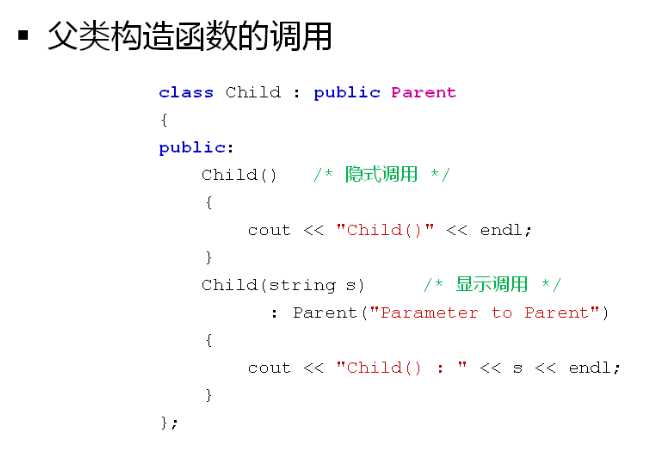标签:turn 继承 return end 声明 创建 string parent src
1、子类中可以定义构造函数
2、子类构造函数:必须对继承来的成员进行初始化
(1)、直接通过初始化列表或者赋值方式进行初始化(但可能继承来的是private成员)
(2)、调用父类构造函数进行初始化
A、默认调用:适用于无参构造函数和使用默认参数的构造函数
B、显示调用:通过初始化列表进行调用(适用于所有父类的构造函数)

#include<iostream> #include<string> using namespace std; class Parent { public: Parent() { cout << "Parent()" << endl; } Parent(string s) { cout << "Parent(string s):" << s << endl; } }; class Child : public Parent { public: Child()//隐式调用父类构造函数,调用的是无参构造函数 { cout << "Child()" << endl; } Child(string s) : Parent(s)//显示调用父类构造函数,若这里不显示调用,则会默认调用无参构造函数 { cout << "Chind(string s):" << s << endl; } }; int main() { Child c;//先输出Parent()再输出Child(), 说明先调用父类的构造函数 Child cc("cc");//先输出Parent(string s):cc 再输出Child(string s):cc return 0; }
1、构造规则
(1)、子类对象在构造时会首先调用父类对象的构造函数
(2)、先执行父类构造函数在执行子类构造函数
(3)、父类构造函数可以被隐式调用或者显示调用
2、构造顺序:先父母、后客人、再自己
(1)、调用父类的构造函数
(2)、调用成员变量的构造函数(与声明顺序相同)
(3)、调用自身的构造函数
3、析构顺序:与构造函数相反
(1)、调用自身的构造函数
(2)、调用成员变量的构造函数
(3)、调用父类的构造函数
#include<iostream> #include<string> using namespace std; class Object { string ms; public: Object(string s) { ms = s; cout << "Object(string s)" << s << endl; } ~Object() { cout << "~Object():" << ms << endl; } }; class Parent : public Object { string ms; public: Parent(string s) : Object(s) { ms = s; cout << "Parent(string s):" << s << endl; } ~Parent() { cout << "~Parent():" << ms << endl; } }; class Child : public Parent { Object mO1; Object mO2; string ms; public: Child(string s) : Parent(s), mO1(s + "1"), mO2(s + "2") { cout << "Child(string s):" << s << endl; ms = s; } ~Child() { cout << "~Child()" << ms << endl; } }; int main() { Child cc("cc");//先父母、后客人、再自己 cout << endl; return 0; } //输出结果 /* Object(string s)cc Parent(string s):cc Object(string s)cc1 Object(string s)cc2 Child(string s):cc ~Child()cc ~Object():cc2 ~Object():cc1 ~Parent():cc ~Object():cc */
1、子类对象在创建时需要调用父类对象的构造函数进行初始化
2、先执行父类构造函数然后执行成员构造函数
3、父类构造函数显示的调用要在初始化列表出
4、子类对象在销毁时需要调用父类对象的析构函数进行清理
5、析构顺序与构造顺序对称相反
标签:turn 继承 return end 声明 创建 string parent src
原文地址:http://www.cnblogs.com/gui-lin/p/6367520.html